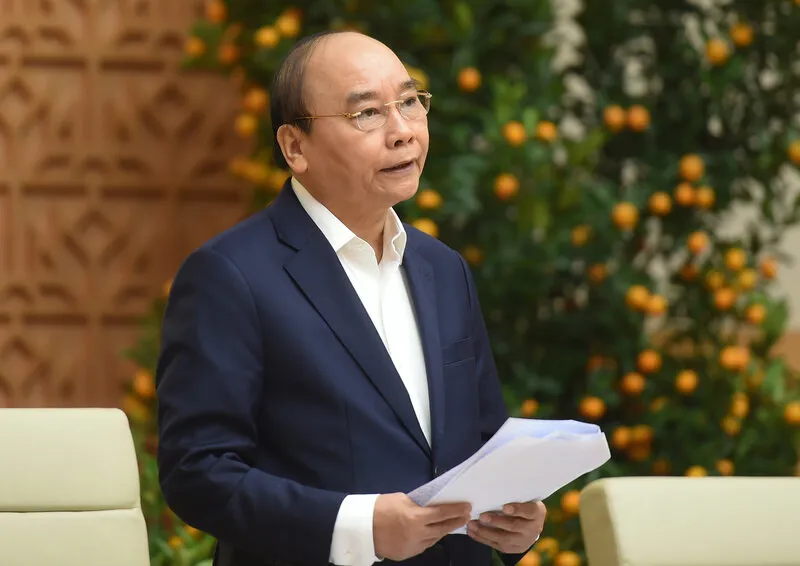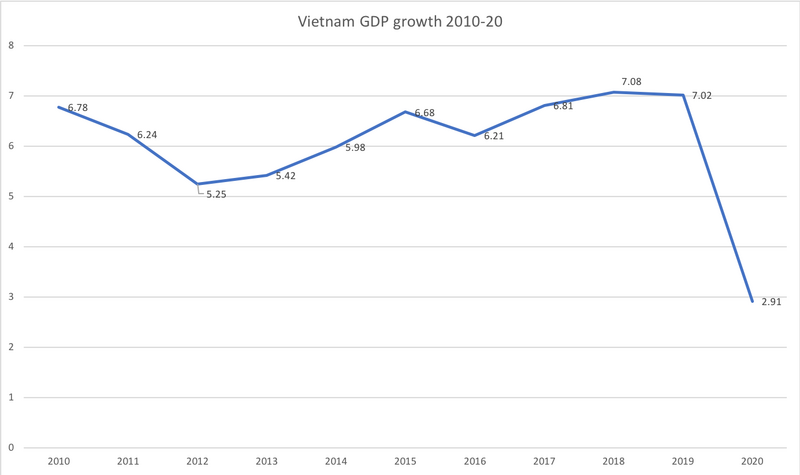Twin goal – Vietnam’s compass for defeating Covid-19
Entering 2021, Vietnam will continue its recovery momentum by benefiting from domestic consumption, stable trade growth, and FDI inflows.
While 2020 was a dark year for the world given the severe consequences of the Covid-19 pandemic, Vietnam has written a story with a bright finale and set an example for others to look up to.
Vietnam ended the year with positive GDP growth of 2.91%, the lowest in a decade but among the world’s highest, while the rest of the world was in deep recessions.
But more importantly, with a population of over 95 million and a shared border with China, the world’s first Covid-19 epicenter, Vietnam has managed to flatten the Covid-19 curve and maintained a total number of cases of around 1,400 (by the end of 2020), thanks to the authorities’ rapid and effective containment efforts, noted the HSBC report.
| Prime Minister Nguyen Xuan Phuc in a government meeting. Photo: Quang Hieu |
“The result showcased Vietnam’s success in pursuing the dual target of both containing the pandemic and boosting economic recovery,” stressed Prime Minister Nguyen Xuan Phuc in a government meeting in late 2020.
During the pandemic, world governments were struggling to choose to fight Covid-19 at full force but leave the economy in disarray, or keeping the economy going but putting people’s lives at risk.
In Vietnam, the answer was clear since the first outbreak in the country which is to pursue the challenging twin goal of both containing the pandemic and boosting economic recovery.
The success, however, did not come easily but from the hard-learned lesson as senior officials were quick to point out a partial stay-at-home entailing only localities hit by Covid-19, instead of adopting nationwide distancing measures, would be the effective solution going forward.
“The nationwide distancing campaign implemented in the first 15 days of April was one of the key factors leading to the GDP growth in the second quarter at just 0.36% year-on-year,” Vice Minister of Planning and Investment Tran Quoc Phuong said at a monthly government press meeting on August 3.
| Chart: Ngoc Thuy |
As time went on, the government’s experience in dealing with the pandemic and strong level of public support helped contain the situation, in turn creating room for Vietnam to mobilize resources for economic recovery.
“Vietnam has acted quickly with various relief programs, including financial support for vulnerable people, waiving and freezing of taxes and fees,” Nguyen Minh Cuong, principal country economist of the Asian Development Bank (ADB) in Vietnam, told The Hanoi Times.
The country also wasted no time in finalizing negotiation or signed major trade deals of UKVFTA EVFTA and RCEP in 2020, which economist Nguyen Minh Phong, in an interview with The Hanoi Times, said such deals would help keep Vietnam’s mid-and long-term economic prospects positive given the country’s a trade-to-GDP ratio of 210%, a high level of economic openness.
Prime Minister Nguyen Xuan Phuc suggested these major deals would bring “more opportunities for export, trade, tourism and serve as a key factor for Vietnam to push forward with administrative reform and improve the business environment.”
According to CEO of HSBC Vietnam Tim Evans “Vietnam will be able to diversify export markets and trading partners, which is also one of the best ways to minimize risks from excessive dependence on a specific trading partner which Covid-19 has made this risk apparent,” he noted.
While strong efforts from the government were key to keep the platform for growth intact, the local business community was quick to adapt to new normalcy and take advantage of the situation to move the economy forward.
Evans pointed to the “remarkable determination” of the Vietnamese business community as they are constantly looking to find ways to overcome the challenges.
According to the recently published HSBC Navigator report, 68% of Vietnamese companies implemented changes over the last 12 months to cope with the pandemic. In addition, moving forward, they intend to focus their investment on sales channels, up-skilling their workforce, enhancing the customer experience, and improving cash flow/capital management in 2021.
“They also intend to invest in technologies that will help improve speed to market, customer targeting, and enhance automation/ operational efficiency,” he noted.
Needless to say, their resilience served as the engine for Vietnam’s two major drivers for growth, namely, manufacturing and exports.
| Production of home appliances at Sunhouse Group. Photo: Thanh Hai |
While manufacturing and processing grew 5.82%, or 1.25% percentage points to the economy, Vietnam recorded an all-time high trade surplus of $19.1 billion in 2020, far exceeding the record figure of $10.9 billion in 2019.
As the standout economy in the region, the International Monetary Fund (IMF) in its latest World Economic Outlook report expected Vietnam’s nominal GDP to reach $340.6 billion in 2020, ranking fourth in Southeast Asia for the first time by overtaking Singapore ($337.5 billion) and Malaysia ($336.3 billion).
In the region, Vietnam’s economic size is behind Indonesia with $1.08 trillion, Thailand ($509.2 billion), and the Philippines ($367.4 billion). Additionally, the country’s GDP per capita would be nearly $3,500 which remains sixth among ASEAN countries, and could rise to $5,211 by 2025.
Brand Finance also singled out Vietnam as the fastest growing nation brand in 2020’s ranking, moving up nine ranks to 33rd with $319 billion to be in the world’s top 100 nation brands from its previous 42nd in 2019, rising 29% year-on-year in value or $72 billion.
“Vietnam, which has recorded staggeringly low Covid-19 cases and deaths, has emerged as one of the top locations within the Southeast Asian region for manufacturing, and has become an increasingly attractive destination for investors - particularly from the US - that are looking to relocate their China operations following the fallout from the US-China trade war,” stated the report.
Entering 2021, Vietnam will continue its recovery momentum by benefiting from domestic consumption, stable trade growth, and FDI inflows stated Evans from HSBC Vietnam.
Meanwhile, with its solid macroeconomic background and the ability to handle and repel the pandemic, it is not difficult to see that Vietnam will continue to be a bright investment destination in the region, especially in the electronic component manufacturing industry.
On this view, Cuong from ADB noted that Vietnam remains a country with high economic stability, which is a major advantage in attracting foreign investors to the country.
Indeed, the Vietnamese government suggests that the country's successful fight against the pandemic "demonstrates to foreign investors that the country is safe for long-term business, and in a broader picture, to win trust from the international community".
This is no doubt has justified the government’s decision in pursuing the twin goal.



.jpeg)








